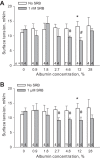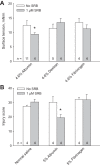Sulforhodamine B interacts with albumin to lower surface tension and protect against ventilation injury of flooded alveoli
- PMID: 25414246
- PMCID: PMC4312850
- DOI: 10.1152/japplphysiol.00818.2014
Sulforhodamine B interacts with albumin to lower surface tension and protect against ventilation injury of flooded alveoli
Abstract
In the acute respiratory distress syndrome, alveolar flooding by proteinaceous edema liquid impairs gas exchange. Mechanical ventilation is used as a supportive therapy. In regions of the edematous lung, alveolar flooding is heterogeneous, and stress is concentrated in aerated alveoli. Ventilation exacerbates stress concentrations and injuriously overexpands aerated alveoli. Injury degree is proportional to surface tension, T. Lowering T directly lessens injury. Furthermore, as heterogeneous flooding causes the stress concentrations, promoting equitable liquid distribution between alveoli should, indirectly, lessen injury. We present a new theoretical analysis suggesting that liquid is trapped in discrete alveoli by a pressure barrier that is proportional to T. Experimentally, we identify two rhodamine dyes, sulforhodamine B and rhodamine WT, as surface active in albumin solution and investigate whether the dyes lessen ventilation injury. In the isolated rat lung, we micropuncture a surface alveolus, instill albumin solution, and obtain an area with heterogeneous alveolar flooding. We demonstrate that rhodamine dye addition lowers T, reduces ventilation-induced injury, and facilitates liquid escape from flooded alveoli. In vitro we show that rhodamine dye is directly surface active in albumin solution. We identify sulforhodamine B as a potential new therapeutic agent for the treatment of the acute respiratory distress syndrome.
Keywords: acute respiratory distress syndrome; alveolar mechanics; rhodamine; surface tension; ventilation injury.
Copyright © 2015 the American Physiological Society.
Figures












References
-
- Bachofen H, Schürch S, Michel RP, Weibel ER. Experimental hydrostatic pulmonary edema in rabbit lungs. Morphology. Am Rev Respir Dis 147: 989–996, 1993. - PubMed
-
- Bastacky J, Lee CY, Goerke J, Koushafar H, Yager D, Kenaga L, Speed TP, Chen Y, Clements JA. Alveolar lining layer is thin and continuous: low-temperature scanning electron microscopy of rat lung. J Appl Physiol 79: 1615–1628, 1995. - PubMed
-
- Behrens H, Beims U, Dieter H, Dietze G, Eikmann T, Grummt T, Hanisch H, Henseling H, Käß W, Kerndorff H, Leibundgut C, Müller-Wegener U, Rönnefahrt I, Scharenberg B, Schleyer R, Schloz W, Tilkes F. Toxicological and ecotoxicological assessment of water tracers. Hydrogeol J 9: 321–325, 2001.
-
- Brower RG, Fessler HE. Another “negative” trial of surfactant. Time to bury this idea? Am J Respir Crit Care Med 183: 966–968, 2011. - PubMed
-
- Douglas GR, Grant CE, Bell RD, Salamone MF, Heddle JA, Nestmann ER. Comparative mammalian in vitro and in vivo studies on the mutagenic activity of rhodamine WT. Mutat Res 118: 117–125, 1983. - PubMed
Publication types
MeSH terms
Substances
Grants and funding
LinkOut - more resources
Full Text Sources
Other Literature Sources

